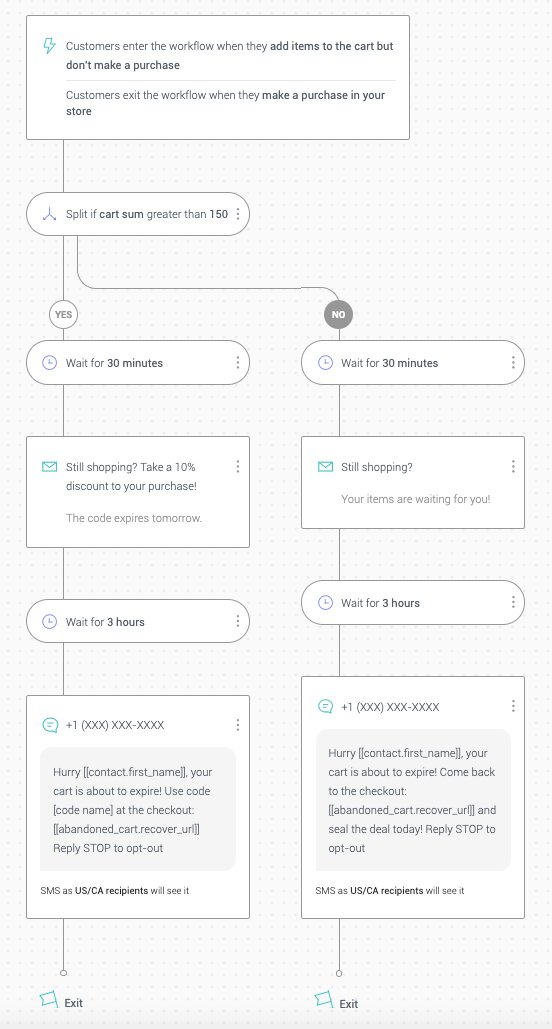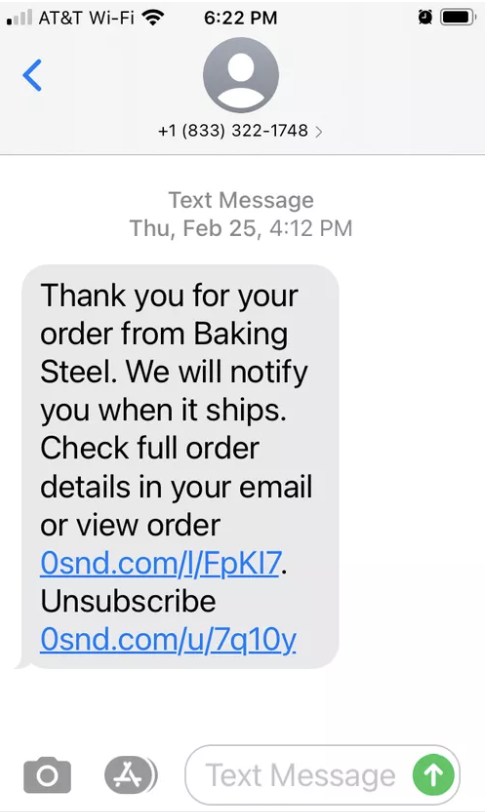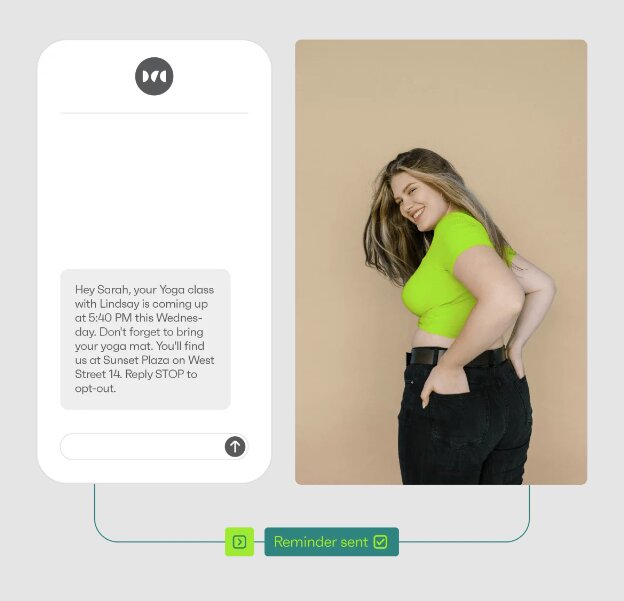Many business owners have groundless fears regarding SMS marketing.
Sometimes, they believe customers don’t want to receive text messages. Some even think customers ignore or delete messages without reading them or find them spammy.
But the reality is very different. SMS marketing is one of the most influential and cost-effective ways to engage your audience.
In fact, SMS marketing campaigns netted brands 23.8% more orders in 2022 than in 2021. This was after brands sent 62.3% more campaign SMS in 2022, reaching nearly 100 million message sends.
An SMS marketing campaign is easy to set up, manage, and track. You can create personalized, targeted, and timely campaigns for various purposes, including:
- Promotions and discounts
- Sending reminders and confirmations
- Requesting feedback
- Loyalty rewards
So, you’re losing severe revenue if you’re not using SMS marketing for your business.
In this article, we’ll dive into the world of SMS marketing, from best practices to real-world examples. Read on to learn how to create and run a successful SMS marketing campaign.
What is SMS marketing?
SMS marketing is a potent digital marketing strategy involving SMS (short message service).
It involves sending marketing communications through text messages to a recipient’s mobile phone.
Key components of an SMS marketing campaign
A few key components make up an effective SMS marketing campaign. These include:
- Permission-based messaging: Businesses must get explicit consent from recipients before sending promotional messages. Opt-in processes ensure recipients’ genuine interest. This reduces the likelihood of spam complaints while ensuring compliance with privacy regulations.
- Concise messaging: SMS messages generally have a 160-character limit. This forces marketers to be concise and to the point. This brevity forces you to craft compelling and highly focused messages.
- Personalization: SMS marketing allows for a high degree of personalization. You can address recipients by their first name. You can also tailor messages based on their preferences and past interactions. This makes the communication more relevant and engaging.
- Automation: Like with other digital marketing channels, you can automate SMS marketing. Consider drip campaigns, which allow sending a series of pre-scheduled messages. These nurture leads and guide them through the customer journey.
- Integration: SMS marketing can operate in isolation and complement other marketing channels, such as email and social media. Combining SMS with email, for example, creates a powerful omnichannel strategy.
Benefits of an SMS marketing campaign
SMS marketing has many benefits for businesses of all sizes and industries. Some of the main advantages are:
- High Engagement: SMS messages have an impressive open rate. Most people check their phones frequently and read their texts almost immediately. This makes it easy to reply to your texts or click on a link to take action.
- Immediate impact: SMS is a real-time communication channel. Instant message delivery makes this channel perfect for flash sales and limited-time offers. One can also send alerts, confirmations, or event reminders.
- Cost-effective: Compared to traditional marketing methods, SMS marketing is cost-effective. Expensive print materials aren’t needed. Done right, an SMS marketing campaign will also generate a high return on investment.
- Trackable: Marketers can track the success of SMS campaigns through several metrics. These include delivery rates, click-through rates, and conversion rates. This allows for data-driven optimization.
- Personalization: SMS messages can be personalized with subscriber first names, interests, and more to boost engagement. Personalized texts see higher open and click-through rates.
- Targeting: Businesses can segment their SMS list based on preferences and behaviors to send targeted and relevant content to specific groups of subscribers. This increases relevance.
- Integration: Many SMS platforms integrate seamlessly with email marketing, CRM, and analytics programs. This provides a unified view of all customer interactions and campaign performance.
How to make an SMS marketing campaign
Creating a successful SMS marketing campaign requires careful planning and execution. The following steps will help you craft an effective SMS marketing campaign. Follow them to harness SMS marketing’s full potential.
1. Pick the right SMS platform
The right SMS marketing software is crucial for creating and managing effective campaigns. Consider factors like:
- Email integration — Does it sync SMS with your email platform?
- Contact management — Can it organize subscribers and groups?
- Automation — Does it allow you to set up automated SMS workflows?
- Analytics — Does it provide reports on clicks, conversions, locations, etc?
- Ease of use — Is the platform intuitive and easy to navigate?
Selecting software with robust SMS capabilities will make executing campaigns seamless. We discuss some excellent options later in this article.
2. Combine email and SMS
Upload your subscriber list to your SMS marketing campaign software.
Remember, email and SMS are complementary channels. They can work together to increase your reach, engagement, and conversions.
For example, you can use email to:
- Introduce your brand
- Provide valuable content
- Build trust
Then, you can use SMS to send timely reminders, abandoned cart reminders and offers. You can also use SMS to boost your email open rates.
You need only send a text message to subscribers who didn’t open your email, inviting them to check it out. This email+SMS combo amplifies results.
Many solutions like Klaviyo and Omnisend integrate SMS with your email. This ensures you reach your audience through several touchpoints. The result is an increased likelihood of conversions.
3. Segment and personalize your messages
Your subscribers aren’t all the same, so you shouldn’t send them the same messages.
They have different preferences, behaviors, and stages in the customer journey. That’s why you need to segment your audience into smaller groups based on criteria such as:
- Activity
- Interests
- Location
- Purchase history
This way, you send relevant and personalized messages matching their needs and expectations.
For example, you can send different offers based on their purchase frequency. Or you could have different reminders based on their appointment date.
You can also use personalization tokens such as their name or order number. These make your messages more human and friendly.
4. Set up keywords and shortcodes
Keywords and shortcodes allow subscribers to engage with your brand via text.
For example, you could tell customers to text “DEALS” to your shortcode to receive promo offers. Or text “HELP” for assistance.
Keywords and shortcodes facilitate two-way conversations and self-service for customers. They also make it easy to opt-in subscribers on-demand.
Just make sure you have a system to auto-respond when keywords are texted to your business shortcode. This boosts engagement through SMS.
5. Time, test, and optimize
When and how often you send your SMS messages can greatly affect your results. Consider your audience’s time zones and preferences when scheduling SMS deliveries.
A/B testing can help identify the optimal sending times for your specific audience. It can also help you experiment with different message variations and CTAs. This optimizes the effectiveness of your SMS marketing campaign.
6. Provide value and respect opt-outs
Make it easy for recipients to opt out of your SMS messages.
Additionally, always honor unsubscribe requests promptly. This helps you maintain a positive brand image and remain compliant with regulations.
Ultimately, your SMS marketing campaign should offer value to your audience.
That could be through exclusive discounts, helpful tips, or timely information. Whatever the case, delivering value builds trust and fosters long-term customer relationships.
SMS opt-in
Getting subscriber consent is crucial for any SMS marketing campaign.
With SMS opt-in, your customers or prospects allow you to send them text messages. These can be for promotional offers, updates, reminders, or other relevant information.
 Image via Omnisend
Image via Omnisend
Let’s delve into the importance of SMS opt-in and how to build a compliant and engaged subscriber base.
The significance of SMS opt-in
- Legal compliance: Many countries have strict regulations governing SMS marketing. These include the Telephone Consumer Protection Act (TCPA) in the United States. Europe has the General Data Protection Regulation (GDPR).
These laws require explicit consent from individuals before sending them marketing messages. Failure to comply can result in hefty fines and damage to your brand’s reputation.
- Engaged audience: Opt-in subscribers are more likely to engage with your SMS content. They’ve shown interest in your brand and willingly shared their contact information.
This indicates a higher level of receptiveness to your messages. We can’t say the same for contacts gotten from purchased lists.
- Reduced spam complaints: Unsolicited texts are more likely to end up reported. This can negatively impact your sender reputation and result in delivery issues.
Focusing on opt-in subscribers lowers the risk of blocking and spam complaints.
How to build an SMS opt-in list
There are several steps you must follow when collecting SMS opt-in from your contacts:
- Clear consent: Make sure that subscribers understand what they are signing up for. Clearly communicate the type of messages they’ll receive. State the frequency and any associated costs.
- Double opt-in: Put in place a double opt-in process. Here, subscribers confirm their subscription by responding to a confirmation message. This adds an extra layer of consent and helps prevent accidental signups.
- Prominent placement: Feature your SMS opt-in option prominently. Have it on your website, social media profiles, and in-store locations. Use compelling calls to action to encourage signups.
- Incentives: Make it clear that opting in provides tangible benefits. Offer incentives like discounts and exclusive offers. Urge signups with an invite like, “Text JOIN to 12345 to receive exclusive deals and news from us.”
- Segmentation: As subscribers opt in, segment them based on their preferences and interests. This allows you to send targeted messages that resonate with specific audience segments.
- Transparency: Be transparent about data usage and privacy. Assure subscribers that you’ll keep their information secure. Let them know you’ll only use their data for the intended purpose. Also, include a link to your privacy policy.
- Easy opt-out: Make it as easy for subscribers to opt out as it is to opt in. Include clear instructions on how to unsubscribe in every message. This can be as easy as telling them to, “Reply STOP to unsubscribe” or providing an unsubscribe link.
Building a permission-based SMS opt-in list takes time. Yet, it’s essential for long-term success when you’re doing an SMS marketing campaign.
SMS marketing drip campaigns
A powerful way to deploy SMS marketing is through automated drip campaigns.
But just what is an SMS drip marketing campaign?
It’s a series of messages sent automatically to your subscribers. They’re based on certain triggers or conditions.
For example, you can send a welcome message to a new subscriber, followed by a discount offer after a few days. Then, a reminder message to use the offer before it expires.
Another example is an abandoned cart workflow. See it below. You can start with an email reminder, and if it goes unnoticed, you can follow up with a text message. Also, pay attention to the varying incentives: larger carts can be encouraged with a discount, while smaller ones simply receive a reminder.
 Image via Omnisend
Image via Omnisend
A drip campaign can help you nurture your leads through the sales funnel. It helps increase conversions and build customer loyalty.
Best practices for SMS marketing drip campaigns
Follow these key guidelines to execute an effective SMS drip campaign:
- Limit frequency: Avoid overwhelming subscribers with excessive texts. Restrict drip campaigns to 4-6 messages over a 1-2 week period. This controlled approach ensures engagement without annoyance.
- Offer exclusive value: Provide subscribers with exclusive benefits. These can include special discounts, promotions, or insider information. Have them available only through the drip campaign to entice engagement and loyalty.
- Drive to action: Each text should conclude with a compelling Call to Action (CTA). This should instruct recipients on what specific action to take next. Clarity prompts an immediate response.
- Automate for ease: Leverage SMS platforms to schedule and automate drip campaigns. Automation ensures precise timing and reduces manual effort.
- Provide opt-out: Include clear and straightforward opt-out instructions in every message. Respecting subscribers’ preferences is crucial for maintaining a positive brand image.
- Content variety: Offer a mix of content types within your drip campaign. These include product highlights, educational tips, and customer success stories. Diversifying content keeps recipients engaged.
- Data security: Prioritize the security of subscriber data. Implement robust security measures to protect sensitive information and comply with SMS regulations. This helps build trust with your audience.
Following these best practices ensures your subscribers receive an engaging, valuable experience. The result is higher open rates and increased loyalty. You also enjoy more conversions compared to single promotional blasts.
Seven SMS marketing campaign examples
SMS marketing campaigns drive results by reaching customers directly on their phones. Some great examples include:
1. Flash sale alert
Campaign objective: Drive immediate sales by creating a sense of urgency.
Example: Aero VIPs introduces a Weekend sale, a BOGO-style offer, and short info on opting out.
 Image via raange.com
Image via raange.com
2. Abandoned cart recovery
Campaign objective: Re-engage potential customers with items in their online shopping carts. Persuade them to complete their purchase.
Example: Florist sends an MMS with a personalized reminder to come back.
 Image via Klaviyo
Image via Klaviyo
3. “Thank you” message
Campaign objective: Confirm the order and provide valuable information.
Example: Baking Steel sends a ‘Thank you’ message with the order confirmation and a link to see all details. Wouldn’t you be happy to receive such a message?
 Image via sproutsocial.com
Image via sproutsocial.com
4. Personalized recommendations
Campaign objective: Boost customer engagement by offering personalized product recommendations. Base these on past purchases.
Example: This SMS marketing campaign by Lunar tailors recommendations to customer preferences and adds a personal touch to the text.
 Image via Omnisend
Image via Omnisend
5. Loyalty program updates
Campaign objective: Keep loyal customers informed about their rewards and encourage continued engagement.
Example: This message notifies the receiver about points earned and their new status. It also offers a special discount to appreciate the loyal customer.
 Image via Omnisend
Image via Omnisend
6. Feedback request
Campaign objective: Gather reviews or valuable feedback to improve future products or offerings.
Example: Calpak sends recent shoppers a review request using the SMS channel. To incentivize the buyers, the brand adds a link in the message encouraging upselling.
 Image via Attentive
Image via Attentive
7. Appointment reminders
Campaign objective: Reduce no-shows and improve customer satisfaction by sending appointment reminders.
Example: This yoga class instructor sends a handy reminder with time and directions. The crisp SMS contains all the information her clients need about their appointments.
 Image via Omnisend
Image via Omnisend
SMS marketing software
Sending text messages to augment other marketing channels seems straightforward enough. So, why would anyone need an SMS marketing campaign software?
At the basic level, to create, send, and track your messages. But also to segment your audience, personalize your content, and measure your results.
There are different types of SMS marketing campaign software available. These include standalone and integrated email+SMS solutions.
Standalone SMS Marketing Tools
- EZ Texting: A text marketing solution that caters to businesses of all sizes. It offers conversational and mass texting and a memorable 5-6 digit textable number. It has dynamic images and list growth tools like QR codes.
You also get contact management and a reporting dashboard. EZ Texting offers solid features at affordable pricing. It’s ideal for smaller businesses getting started with text marketing.
- Twilio: A cloud communications platform offering enterprise-grade SMS marketing. Beyond text marketing, Twilio offers voice, video, and authentication solutions.
It provides the flexibility to build custom SMS applications using its APIs. As such, it’s preferred by developers looking to integrate SMS into their applications. It may not be ideal for beginners.
If you’d like to take your SMS marketing campaign to the next level, consider using an email+SMS platform.
These platforms combine the power of email marketing and SMS marketing in one place. Some of them work in tandem, through omnichannel campaigns that reach customers across multiple channels. It’s the best way to increase your conversions.
Email+SMS Marketing Tools
- Omnisend: An ecommerce focused email+SMS marketing platform. It excels in combining email and SMS marketing for highly personalized messaging.
Omnisend enables marketers to create seamless customer journeys with email, SMS and web push notifications involved. It’s exceptional affordability and visual email and SMS builders make campaign creation easy.
A significant advantage is that Omnisend sends international text messages.
- Klaviyo: Also offers deep integration of email and SMS marketing. It allows you to create automated omnichannel flows and segment your audience effectively.
You can also leverage data-driven insights to optimize your campaigns. However, Klaviyo has a limited list of countries where its SMSes can be sent.
- Privy: Offers email and SMS marketing capabilities. This comes alongside features like pop-ups, cart abandonment emails, and audience segmentation.
You can choose from their more than 60 SMS templates to get started.
However, on Privy, you can’t combine email and SMS in the same workflow like on Klaviyo or Omnisend.
- GetResponse: Offers a range of marketing solutions, including email and SMS marketing. It provides user-friendly automation tools and analytics to track your campaigns’ performance.
You can send texts to imported phone number databases without linked email addresses. It also allows shortening links directly in the SMS creator to save characters.
- ActiveCampaign: Seamlessly integrates email and SMS marketing. It offers automation recipes, conditional content, and advanced audience segmentation.
However, ActiveCampaign has a steep learning curve that necessitates technical help.
Wrap up
SMS marketing is highly effective.
Smart businesses can leverage it for its high open and response rates. Indeed, a well-executed and targeted SMS marketing campaign will drive sales and engagement.
Follow permission-based principles, personalize, and automate your messages. You’ll be able to cut through the noise to reach customers directly.
When selecting SMS marketing software, examine your specific needs, budget, and integration requirements.
Standalone tools like EZtexting and Twilio are excellent for focused SMS campaigns. But email+SMS solutions like Omnisend, Klaviyo, and ActiveCampaign offer a comprehensive approach to omnichannel marketing.
Ultimately, SMS is a powerful medium that complements your broader marketing mix. Combine it with email and other marketing efforts for an impactful and engaging customer experience.
